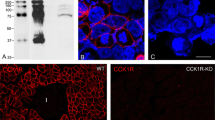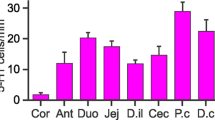Summary
Enterochromaffin cells of the rat duodenum have been studied immunocytochemically by use of a specific antiserum to serotonin. At the light-microscopic level serotonin immunoreactivity was observed in enterochromaffin cells located in the epithelium of the duodenal mucosa. Most of the serotonin-immunoreactive material was localized to the basal portion of the enterochromaffin cells, but small amounts of immunoreactive material were regularly observed in the apical portion. At the electron-microscopic level serotonin immunoreactivity in enterochromaffin cells was found to be concentrated over the dense cores of the cytoplasmic granules. The majority of these granules was located in the basal cytoplasm of the enterochromaffin cells, but serotonin-immunoreactive granules were also observed in the apical cytoplasm immediately beneath the microvilli. These observations indicate that duodenal enterochromaffin cells are bipolar and that they secrete serotonin both basally, to the circulation, and apically, to the gut lumen. Rat duodenal enterochromaffin cells thus appear to have an exocrine as well as an endocrine function.
Similar content being viewed by others
References
Ahlman H (1976) Fluorescence histochemical studies on serotonin in the small intestine and the influence of vagal nerve stimulation. Acta Physiol Scand [Suppl] 437:1–30
Ahlman H, DeMagistris L, Zinner M, Jaffe BM (1981) Release of immunoreactive serotonin into the feline gut lumen in response to vagal nerve stimulation. Science 213:1254–1255
Ahlman H, Grönstad KO, Nilsson O, Dahlström A (1984) Biochemical and morphological studies on the secretion of 5-HT into the gut lumen of the rat. Biogenic Amines 1:63–73
Barter R, Pearse AGE (1953) Detection of 5-hydroxytryptamine in mammalian enterochromaffin cells. Nature 172:810
Barter R, Pearse AGE (1955) Mammalian enterochromaffin cells as the source of serotonin (5-hydroxytryptamine). J Pathol Bacteriol 69:25–31
Burks TF, Long JP (1966) Catecholamine-induced release of 5-hydroxytryptamine (5-HT) from perfused vasculature of isolated dog intestine. J Pharmacol Sci 55:1383–1386
Bülbring E, Lin RCY (1958) The effect of intraluminal application of 5-hydroxytryptamine and 5-hydroxytryptophan on peristalsis; the local production of 5-HT and its release in relation to intraluminal pressure and propulsive activity. J Physiol (Lond) 140:381–407
Dey RD, Hoffpauir J (1984) Ultrastructural immunocytochemical localization of 5-hydroxytryptamine in gastric enterochromaffin cells. J Histochem Cytochem 32:661–666
Erspamer V, Asero B (1952) Identification of enteramine, the specific hormone of the enterochromaffin cell system, as 5-hydroxytryptamine. Nature 169:800–801
Fujita T, Osaka M, Yanatori Y (1974) Granule release of enterochromaffin (EC) cells by cholera enterotoxin in the rabbit. Arch Histol Jpn 35:367–378
Geffard M, Dulluc J, Rock AM (1985) Antisera against the indolealkylamines: tryptophan, 5-hydroxytryptophan, 5-hydroxytryptamine, 5-methoxytryptophan and 5-methoxytryptamine tested by an enzyme-linked immunosorbent assay method. J Neurochem 44:1221–1228
Grönstad KO, Ahlman H, Dahlström A, Jaffe BM, Lidberg P, Zinner MJ (1984) The effects of vagal nerve stimulation on the levels of serotonin and substance P in the portal vein of the cat. Biogenic Amines 1:303–311
Grönstad KO, DeMagistris L, Dahlström A, Nilsson O, Price B, Zinner MJ, Jaffe BM, Ahlman H (1985) The effects of vagal nerve stimulation on endoluminal release of serotonin and substance P into the feline small intestine. Scand J Gastroenterol 20:163–169
Heitz P, Polak JM, Timson CM, Pearse AGE (1976) Enterochromaffin cells as the endocrine source of gastrointestinal substance P. Histochemistry 49:343–347
Heitz P, Polak JM, Kasper M, Timson CM, Pearse AGE (1977) Immunoelectron cytochemical localization of motilin and substance P in rabbit bile duct enterochromaffin (EC) cells. Histochemistry 50:319–325
Horisberger M, Clerc M-F (1985) Labelling of colloidal gold with protein A. A quantitative study. Histochemistry 82:219–223
Hsu S-M, Raine L (1981) Protein A, avidin and biotin in immunohistochemistry. J Histochem Cytochem 29:1349–1353
Johansson O, Backman J (1983) Enhancement of immunoperoxidase staining using osmium tetroxide. J Neurosci Methods 7:185–193
Kobayashi S, Fujita T (1973) Emeiocytotic granule release in the basal-granulated cells of the dog induced by intraluminal application of adequate stimuli. In: Fujita T (ed) Gastro-enteropancreatic endocrine system — A cell-biological approach. Igaku Shoin, Tokyo, pp 49–58
Nilsson O, Ericson LE, Dahlström A, Ekholm R, Steinbusch HWM, Ahlman H (1985) Subcellular localization of serotonin immunoreactivity in rat enterochromaffin cells. Histochemistry 82:351–355
Pettersson G (1979) The neural control of the serotonin content in mammalin enterochromaffin cells. Acta Physiol Scand [Suppl] 470:1–30
Pettersson G, Ahlman H, Bhargava HN, Dahlström A, Kewenter J, Larsson I, Siepler JK (1979) The effect of propranolol on the serotonin concentration in the portal plasma after vagal nerve stimulation in the cat. Acta Physiol Scand 107:327–331
Roth J (1982) The protein A-gold technique — a qualitative and quantitative approach for antigen localization on thin sections. In: Bullock GR, Petrusz P (eds) Techniques in immunocytochemistry, Vol. 1. Academic Press, New York, pp 108–133
Roth J, Bendayan M, Orci L (1978) Ultrastructural localization of intracellular antigens by the use of protein A-gold complex. J Histochem Cytochem 26:1074–1081
Slot JW, Geuze HJ (1985) A new method of preparing gold probes for multiple-labeling cytochemistry. Eur J Cell Biol 38:87–93
Sundler F, Alumets J, Håkanson R (1977) 5-hydroxytryptamine-containing enterochromaffin cells: storage site of substance P. Acta Physiol Scand [Suppl] 452:121–123
Tansy MF, Rothman G, Bartlett J, Farber P, Hohenleitner FJ (1971) Vagal adrenergic degranulation of enterochromaffin cell system in guinea pig duodenum. J Pharmacol Sci 60:81–84
Zinner MJ, Jaffe BM, DeMagistris L, Dahlström A, Ahlman H (1982) Effect of cervical and thoracic vagal stimulation on luminal serotonin release and regional blood flow in cats. Gastroenterology 82:1403–1408
Author information
Authors and Affiliations
Rights and permissions
About this article
Cite this article
Nilsson, O., Ahlman, H., Geffard, M. et al. Bipolarity of duodenal enterochromaffin cells in the rat. Cell Tissue Res. 248, 49–54 (1987). https://doi.org/10.1007/BF01239961
Accepted:
Issue Date:
DOI: https://doi.org/10.1007/BF01239961




